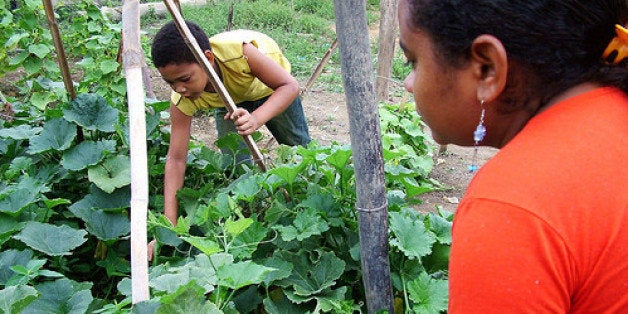
For small farmers -- and those who pay attention to things like climate change, food systems and water -- the answers to ecological sustainability are right under our feet:
Dirt. Soil. Ground. Land.
Community control of these precious resources (terrestrial ecosystems, forests and biodiversity) is critical to achieving "Life on Land," as Goal 15 is known.
The major threat facing life on land, small farmers and those of us who eat (aka all of us) is the global expansion of large-scale, industrial agriculture. Under the guise of the "Green Revolution" and false-promises to "feed the world," industrial agriculture (think Monsanto, Cargill) is hell-bent on expanding these toxic, monocultural practices.
Half of all greenhouse gases are produced by the global-food system, according to the respected international agriculture-research organization, GRAIN. And that's saying something, since transportation and power plants account for massive amounts of pollution that endanger our planet.
Valdir Misnerovicz, a member of Brazil's Landless Workers Movement (MST) spoke about ecological sustainability in stark terms, describing two forces at play in the world right now that he called "the project of death" (i.e., the extraction and exploitation inherent to global capitalism) versus "the project of life" (i.e., solidarity, sustainability, support). "The project of death doesn't care about people, it only cares about capital; it doesn't want to produce food, it wants to produce products... and big profits."
The legacy of industrial agriculture has pushed millions of farmers into debt and hunger, using an industrial model that relies heavily on expensive and toxic chemicals and pesticides.
For Valdir, the better choice is obvious: "Small farmers don't produce commodities, they produce food. Small farming is the farming of hope."
Indeed, 70 percent of the world's food is still produced by small farmers, according to the ETC Group, using only 30 percent of the world's agricultural resources. Agroecology, a new farming-approach movement that combines ecological agriculture with traditional-farming knowledge and small, local farms is fast becoming recognized as the climate-cooling alternative that can out produce industrial agriculture by far. According to a UN report, small-scale farmers can double food production within 10 years in critical regions by using agroecological methods.
Malawi, which had introduced a massive chemical-fertilizer subsidy program a number of years back, began an agroecology program for more than a million of their poorest farmers and found that maize yields increased by two to three times.
Valdir's organization, the MST, has expanded training for agroecology as part of its mission to promote food sovereignty, or the idea and practice of communities making decisions about their own food systems, including controlling the seeds they plant, the methods they use and the food they eat in a sustainable and culturally appropriate way.
Through the MST, more than one and a half million formerly landless people have settled on underutilized land to produce food for themselves and their country. The results continue to transform once-depleted soil into productive farms, provide hundreds of tons of agroecologically produced food for area schools and markets, and incorporate agroforestry to restore nutrients and stability to denuded landscapes.
Valdir spoke during a farmer-learning exchange with 150 participants, including representatives from India, Nepal, Mexico, Brazil and the United States, organized by the Popular Peasant Movement (MCP). A success story in its own right, the MCP's Creole Seed Program saved and produced 273 tons of native seeds last year in just one state alone, including numerous varieties of beans, cassava, corn, squash and other key food crops.
"We have resisted against GMO seeds and pesticides," says Jossier Boleão of the MCP when talking of the greater yields they get from native seeds to the GMO seeds. "And if we save 2,000 reales [by not buying GMO seeds and pesticides] we can plant that much more."
In the process of preserving biodiversity and nurturing soil, the MCP has also reversed land loss and soil degradation. This kind of approach surely does not please industrial giants such as Cargill and Monsanto, who have other designs on the land.
Yet Jossier from the MCP and Valdir from the Landless Workers Movement aren't backing down -- which is a boon to all of us who want to eat healthy food and breathe clean air. Because small farmers like Valdir and Jossier cool the planet and produce more food per hectare than Big Ag.
And in the process, they save the planet.
This post is part of a series produced by The Huffington Post, "What's Working: Sustainable Development Goals," in conjunction with the United Nations' Sustainable Development Goals (SDGs). The proposed set of milestones will be the subject of discussion at the UN General Assembly meeting on Sept. 25-27, 2015 in New York. The goals, which will replace the UN's Millennium Development Goals (2000-2015), cover 17 key areas of development -- including poverty, hunger, health, education, and gender equality, among many others. As part of The Huffington Post's commitment to solutions-oriented journalism, this What's Working SDG blog series will focus on one goal every weekday in September. This post addresses Goal 15.